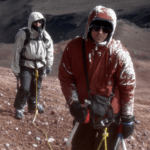Here at Ecuador Eco Adventure, we specialize in bringing people to some of the wildest places on planet Earth. Ecuador is a hot-bed for other-worldly terrain thanks to its location on the Equator, extreme altitudes, and miles of abandoned coastline. It’s considered one of 17 “megadiverse” countries in the entire world. When visiting a country like Ecuador where sublime natural features beckon from every direction, it is in human nature to heed an internal call to conquer, whether that be a peak, a valley, or anything in between. That’s where we come in. Not only are we here to issue clichés like “it’s not going to be easy but it’s going to be worth it”, we also take pride in creating a fun atmosphere, keeping our customers safe, and guiding visitors to the best experiences possible. Since we are based in Riobamba, we find ourselves favoring our summit tours of Chimborazo, the volcano that looms over our hometown. While anyone can enroll in a climb of Chimborazo, we understand a first attempt (or even a fifth or twentieth) at mountaineering can sometimes be intimidating, and because of that we partnered again with our friends at AllTheRooms to break down some things to know.
Stats About Chimborazo
Approximately a three-and-a-half hour drive from the capital of Quito and four-and-a-half hours north of the popular city of Cuenca stands Chimborazo the tallest point in Ecuador. That bragging point is thanks to its summit that stands 6,263 meters, or 20,548 feet, above sea level. While it may be about 9,000 feet short of Everest, because Chimborazo is located on the bulge of the equator, it is actually the closest place on the planet to the moon and the farthest point from the Earth’s core. It is the 15th tallest volcano in the world, but don’t worry, unlike its popular Ecuadorian counterpart, Cotopaxi, Chimborazo is inactive and will not erupt again. Its first successful summit occurred on January 4, 1880, by an Englishman named Edward Whymper.
Preparations
While we encourage any able-bodied, fit person to give the climb a try, it is a physically demanding push to the top. Because of that we highly recommend training and acclimatizing. For those who don’t know, acclimatizing is essentially spending significant time exerting physical energy at altitudes before attempting a mountaineering attempt. To do this we recommend doing other hikes in the area that will require significant exertion and/or climbing other mountains that may not be as tall as Chimborazo, but will at least mirror the steep trek up the face of a peak. As for exercise to focus on prior to arriving in Ecuador, strong legs and a sturdy core will do some good but the best thing would be to have the best cardiovascular health and strength possible before the attempt.
Altitude Sickness and Symptoms
Every portion of the volcano will expose climbers to extreme altitude, which will be strenuous on nearly everyone’s body. Altitude sickness is always a threat and needs to be treated seriously. While the sickness can strike anytime our guides are experts at recognizing symptoms and helping those who need it. It is important to remember that all bodies react differently to altitude; some of the most athletic of people will struggle mightily, while others will not experience as much difficulty. It is common, and likely will happen, that while hiking a climber will feel shortness of breath, a rapid heart rate, and exhaustion. However, once symptoms like chest pain, debilitating headaches, and coughing-up fluid begin, it may be time to call it a day. Safety is a priority to even the most hardened of climbers, it is important to know your body. Also remember due to weather, ice conditions, and altitude illnesses, fewer than 50% of summit attempts on Chimborazo are successful, there is no shame in admiring the view from not quite the top.
Ecuador Eco Adventures Tours
At Ecuador Eco Adventures we are always ready to guide people on a once in a lifetime trek up Mount Chimborazo. Our Chimborazo climb is meant for everyone wanting to give it a try because unlike many other extreme altitude mountains, Chimborazo requires minimal technical mountaineering skill and it is affordable, when realizing the average cost of an Everest expedition is around $35,000. A climb of this magnitude can be scary and it will be hard but our guides are the best in the business. Our team of indigenous guides are all certified by multiple climbing and governmental agencies to ensure our guests’ safety and enjoyment. For those wanting to be ready for the summit, check out our acclimatizing tour, or for those keen on a different path we offer a horseback tour around Chimborazo. Happy climbing!
Author: Zack Davisson
Zack is a recovering technical recruiter who traded in his suit and tie in Silicon Valley for salsa music and a passion for writing in Medellin, Colombia. When not writing for AllTheRooms you can find Zack with his nose in a book, puttering around nature, or getting ultra-competitive while watching Jeopardy.
Jake is originally from Sydney and co-founded Ecuador Eco Adventure with Wlady back in 2006. Together they built one of the country's most prominent climbing and hiking agency that is number one in summit attempts of Chimborazo, Cotopaxi, Antisana, and Cayambe. Ecuador Eco Adventure has since been recommended in National Geographic Adventure, The Rough Guide, and the Lonely Planet.




3 Comments
Hello, my wife and I are climbing Kilimanjaro in march and since we are living in Salinas, Ec on the coast until we leave for Montana in the us to pack up for the trip to Africa we want to do several high altitude trek/climbs so we can be somewhat acclimated. We have done mountaineering before but we have been spending our winters in Ec since 2014 so we need the high altitude exposure. We have already hiked two days in the Caja national park at 10-11K. It is not necessary for us to summit but that would be a bonus. Please give us the details and cost. We are talking about the next couple weeks if possible.
Thanks.
Dear Bob,
Thank you for your comment. Its also a dream of mine to climb Mt Kilamanjaro while it still has snow cover and glacier on its peak. At 6,263 meters, Mount Chimborazo is slightly higher than Kilamanjaro, but the ascent for Chimborazo begins at its base camp at 5,000m (a 1,200m ascent done over several hours the middle of the night) whereas I believe the ascent of the mighty Kilamanjaro begins much closer to its base and takes several days up 4,900 metres (16,100 ft) to the peak. Impressive stuff.
Since you are living on the coast at Salinas, I’d recommend chilling out in Ecuador’s beautiful Andean cities for a few nights and then taking on some treks. The El Altar Lagoons and Ecuadorian Condor Trek will get you to the highest-altitude for a hike, and push and exercise those thigh and calf muscles to the max. There’s also the mount Carihuairazo climb (“the little brother of Chimborazo”), which is half-trek and half-climb, taking you to 5,090m with fantastic views of Chimborazo if the weather permits, or the Illiniza climb at 5,140 which could get you both into great shape for high-altitude.
After you’ve gotten a feel of high-altitude, then climbing Cotopaxi or Chimborazo would be your next best bet. Cotopaxi, at 5,897 m (19,347 ft), is almost EXACTLY the same size as Kilamanjaro, 5,895 metres (19,341 ft) above sea level. That’s a two meter difference.
If you email us on [email protected] can work out a discount package for you guys to take on. We’ll also check our emails multiple times of day so you’ll get a much more prompt reply than here in comment section of the website.
All the best mate,
Wlady
Dear Wlady:
I’m reading about the different options– Chimboraze,Cotopaxi, and others mentioned in the article above and am quite interested. I just summited Kilimanjaro in August and it was a remarkable experience. The altitude only became an issue on the actual summit night, otherwise it was manageable. How about the different Ecuadorian treks,are you trekking above 5K or 6K meters only on the last night or for several days?
Thanks for letting me know.
Miriam